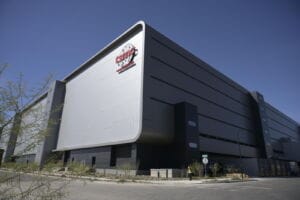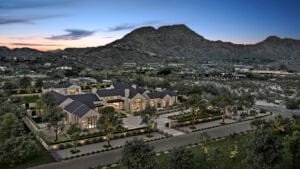The Grand Canyon State continues to be a destination for new residents, with the U.S. Census Bureau estimating that more than 8,300 people became Arizonans each month from April 2020 to July 2021 — nearly 300 a day. As the demand for housing increased, housing costs also grew, with a study from the Arizona Multihousing Association (AMA) and ALN Apartment Data showing that rent prices rose 17.7% over the last year in the Phoenix region to $1,672 per month.
The primary reason for surging rental costs is the mismatch between housing supply and demand in Arizona. AZ Housing for All notes that 17,000 new apartment units are needed annually just to keep up with inbound migration. Even after meeting demand for new residents, local economist Elliott Pollack estimates that Metro Phoenix has a supply shortfall of 15,000 apartments.
READ ALSO: Arizona No. 2 for largest house price appreciation
“When you also consider inflation, difficulties with the supply chain, and the reluctance of cities and towns to approve new housing in the face of not in my backyard (NIMBY) neighbors, we have a perfect storm for a housing crisis,” says Ann Boomsma, senior vice president of operations for MEB Management Services.
For Arizona to remain a hot spot for businesses and transplants, the deficit of rental units must be addressed.
Barriers to building
Earlier this year, House Bill 2674 was introduced in the Arizona Legislature to establish by-right zoning, which would preempt housing regulations established by local municipalities, such as aesthetic design guidelines that don’t impact safety but raise construction costs. Ultimately, the bill was amended to create an 11-member committee to study the housing supply crisis.
Jake Hinman, who directs the government affairs program for the AMA, is on the committee, which he says will continue to meet twice a month until the end of the year. In September, the panel will conduct legislative hearings in four cities — Tuscon, Sedona, Flagstaff and Sierra Vista — to learn more about the local challenges to constructing housing of all types.
The goal for the committee is to compile what they’ve heard over the course of six months and present a report to lawmakers. “Based on the findings, legislators can decide what they want to do in reaction to that,” Hinman explains. “Will it be the same as the original bill? Hard to say, but I think it’s fair to assume that there will likely be bills dealing with regulatory barriers facing builders next legislative session.”
One developer, who asked not to be named to avoid angering any municipalities, notes that in his 35 years of building apartments, nearly every project site had to be rezoned.
“We’re spending significantly more time and money now getting through the approval processes, because [the cities] evaluate more than just the concept of land use now,” he says. “You have to go through extensive engineering, environmental and design analysis before they will weigh in on the merits of a project based on its use.
“In the past,” he continues, “you might spend six months and $100,000 to see if you can get a piece of land rezoned. Now, you’re spending at least three times as much and it takes almost twice as long, if not longer. The whole thing has a knock-on effect on the ability to meet the housing demand requirements we have in our community.”
Nearby residents opposed to a proposed apartment development can also exert influence by pressuring city councilmembers to vote against the rezoning application. Often, these NIMBY attitudes center on concerns around increased traffic, lowering property values or a perceived change in the neighborhood’s character.
“There’s a project in Surprise with about 600 units of low-income housing, with 200 of those units set aside for low-income seniors,” Hinman says. “The NIMBY reaction to it has been intense. There are websites that have gone online to oppose the project.”
Opportunity zone
Building multifamily workforce housing is not only difficult from a zoning approval perspective, but also because of the nature of the development industry which makes building luxury apartments easier.
“Real estate development is not about sticks and bricks in the beginning,” explains Chris Loeffler, co-founder and CEO of Caliber. “It becomes a business of sticks and bricks once the project is approved and financed, but until then, it is a structured finance business.”
Just like any other enterprise, developers are looking to make a profit and typically do so through development fees and profit sharing on the back end. That means developers are motivated to generate projects that will get approved, but they also have to get financed.
“If the cheapest possible financing available is to build Class A multifamily — because those loans are backed by the government — then that’s what [developers] are going to build,” he says. “If they put $2 million of their own money at risk, and someone in city council decides not to approve the project, the developer may as well light that money on fire.”
One solution to this problem is through an investment vehicle called an opportunity zone fund. Investors are rewarded with a tax break if they take their capital and essentially make it illiquid for at least 10 years. During that period, the money is used to build new infrastructure and buildings in lower income communities — known as opportunity zones — which translates to increases in employment and local taxes for that municipality.
Caliber is one of the largest opportunity zone investors in Arizona. Loeffler says the first fund closed with approximately $182 million in equity that will deploy into roughly $500 million worth of projects. A second fund opened in July which is raising $250 million to drive into projects.
“We start by finding an opportunity zone we think is a good location. We can understand what that community needs to have built, instead of saying, ‘The simplest thing for me to find and build is Class A apartments, because that’s easy for me to get financing on,’” he says. “I can go into a community like Downtown Mesa that needs workforce housing, and I can fund it.”
Meeting the demand for housing
Because of the longer timespan afforded to Caliber, thanks to the opportunity zone fund, it can take incrementally more risk with capital and still deliver projects that are profitable for investors. One of those developments is utilizing ZenniHome, which builds affordable manufactured homes, for a 90-unit apartment complex atop 10,000 square feet of retail in Downtown Mesa. Future residents will choose between 320-square-foot studios and 640-square-foot, one-bedroom apartments.
“We’re delivering those units for $80,000 to $100,000 per unit, and the average Class A apartment complex is about $300,000 per unit right now,” Loeffler explains. “If my cost basis is low enough, my rents can come down to something that’s more achievable for the average person. That’s the reason why we invested in that product [ZenniHome] — it’s steel construction and it’s stackable, so I can create a complex out of these instead of one-off units.”
For Hinman, he’s seeing signs of consensus building around the nation that the housing crisis is a result of overly restrictive zoning and land use regulations.
“President Obama talked about zoning in a very strong way in 2016. President Trump signed an executive order in 2019, and he pointed out zoning as an issue. In May, President Biden came out with his housing plan, and he specifically talks about land use. All the major national media sources are now talking about zoning and NIMBYism,” he concludes. “With the diversity of people saying that this is a real issue, I think something is going to happen legislatively. The question is, what’s the scope of it going to be?”




